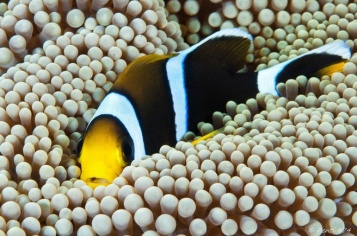Common Name: Mauritian Anemonefish
Scientific Name: Amphiprion chrysogaster (Cuvier, 1830)
Distribution: Mauritius and Réunion. Reported from Toliara, Madagascar. Likely at Tromelin Island and perhaps the Agaléga Islands and the various shoals of the Mascarene Plateau (St. Brandon, Nazareth, Saya de Malha).
Type Locality: Réunion & Mauritius
Identification: Three thin stripes. Body mostly black, yellow restricted to the region surrounding the pelvic fins. Dorsal fin black, a thin white edge to the rays. Caudal fin black in adults, with a white perimeter. Pectoral fins yellow, with the outer edge clear. Pelvic fins yellow, anal fin black. Occasional specimens are entirely melanistic, without any yellow.
Similar: Unusually dark specimens of Amphiprion tricinctus can appear nearly identical melanistic individuals of A. chrysogaster but can be told apart in lacking a white edge to the soft dorsal fin and caudal fin. Otherwise, the normal phenotype of these species are easily told apart based on the overall color patterns. Amphiprion fuscocaudatus has a duskier caudal fin, a yellow anal fin and the soft dorsal fin ray patterned white from an extension of the middle stripe instead of marginally. The Indonesian Amphiprion polymnus can also appear quite similar, especially smaller individuals with thinner stripes. Adults have a noticeably wider and slanted middle stripe, the white margins of the dorsal and caudal fins are wider, the pectoral fins are black, and there is no yellow along the belly.
Notes: Though closely related to other species of the Western Indian Ocean, this species (along with A. fuscocaudalis) feel quite distinct from the others. Though known primarily from the Mascarene Islands, it might be expected as far west as the reefs of Northeastern Madagascar, and it was reported in Astakhov 1996 as occurring at Toliara, in the Southwest of Madagascar. More study is needed to determine the full extent of its range, particularly at the shoals north of Mauritius, which could potentially be found to have its own endemic species.
This is a relative rarity in the aquarium trade that has not been bred in commercial numbers.




















